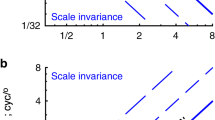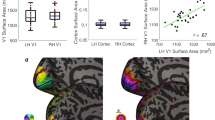Abstract
The different cortical visual cells exhibit a large repertoire of responses to sinusoidal gratings, depending on their receptive field structure and the stimulation parameters. It has been shown previously that the tuning curves and histogram shapes of cell responses are affected by subunit distances. One receptive field model (Spitzer and Hochstein 1985b) incorporated subunit distance but assigned it as a constant parameter, for ease of calculation. Here we investigate different tuning curve properties of various primary cortical cell types during testing of 10 deg of nonuniform distances of the receptive fields' subunits. The effect of nonuniformity was compared for average responses, tuning curve shapes, maximum peak responses, and bandwidths across four cell types of different sizes. The shapes and other properties of tuning curves are usually found to be retained also when the degree of uniformity is not very high for most of the cell types. In addition, the effect of uniformity is compared across these different response properties. The maximum peak responses of the tuning curve are found to display a lower coefficient of variation than the bandwidth, for all cell types, for most degrees of uniformity.
Similar content being viewed by others
References
Adelson EH, Bergen JR (1985) Spatiotemporal energy models for the perception of motion. J Opt Soc Am A 2:284–299
Albrecht DG, Geiser WS (1991) Motion sensitivity and the contrastresponse function of simple cells in the visual cortex Visual Neurosci 7:531–546
Baker CJR, Cynader MS (1987) Space-time separability of direction selectivity in cat striate cortex neurons. Vision Res 28:239–246
Bishop PO, Coombs JS, Henry GH (1973) Receptive fields of simple cells in the cat striate cortex. J Physiol 231:31–60
Camarda RM, Petehans E, Bishop PO (1985) Simple cells in cat striate cortex: responses to stationary flashing and to moving light bars. Exp Brain Res 60:151–158
De Valois RL, Albrecht DG, Threll LG (1982) Spatial frequency selectivity of cells in macaque visual cortex. Vision Res 22:545–559
Duncan JH, Tsai-Chia Chou (1988) Temporal edges: the detection of motion and computation of optical flow. Iccr: 374–382
Fogel I, Sagi D (1989) Gabor filters as texture discriminators. Biol Cybern 61:103–113
Foster KH, Gaska JP, Nagler M, Pollen DA (1985) Spatial and temporal frequency selectivity of neurons in visual cortical areas V1 and V2 of the macaque monkey. J Physiol 365:331–365
Glezer VD, Cooperman Am, Ivanov VA, Tsherbach TA (1976)An investigation of spatial frequency characteristics of complex receptive fields in the visual cortex of the cat. Vision Res 16:789–797
Glezer VD, Tsherbach TA, Gauselman VE, Bondarko VM (1980) Linear and non-linear properties of simple and complex receptive fields in area 17 of the cat visual cortex. Biol Cybern 37:195–208
Glezer VD, Yakovlev VV, Gauzelman VE (1989) Spatial organization of subfields in receptive fields of cells in cat striate cortex. Vision Res 29:7, 777–788
Graham N, Sutter A, Venkkatesan C (1993) Spatial-frequency and orientation-selectivity of simple and complex channels in region segregation. Vision Res. 33:1893–1911
Heeger DJ (1992) Normalization of cell responses in cat striate cortex. Visual Neurosci 9:181–197
Heeger DJ (1993) Modeling simple cell direction selectivity with normalized, half-square, linear operators. J Neurophysiol 70:1885–1898
Heggelund P (1985) Receptive field organization of simple and complex cells. In: Rose D, Dobson VG (eds) Models of visual cortex. Wiley, London
Heitger F, Rosenthaler L, Von der Heydt R, Peterhans (1992) Simulation of neuronal contour mechanisms: from simple to end-stopped cells. Vision Res 32:963–981
Hubel DH, Wiesel TN (1959) Receptive field of single neurons in the cat's striate cortex. J. Neurophysiol 148:547–591
Hubel DH, Wiesel TN (1962) Receptive fields, binocular interaction and functional architecture in the cat's visual cortex. J. Physiol 160:106–154
Jones JP, Stepnonki A, Palmer LA (1987) The two-dimensional spatial structure of simple receptive fields in cat striate cortex. J Neurophysiol 6:1187–1211
Kulikowski JJ, Bishop PO (1981) Linear analysis of the responses of simple cells in the cat visual cortex. Exp Brain Res 44:386–400
Kulikowski JJ, Bishop PO (1982) Silent periodic cells in the striate cortex. Vision Res 22:191–200
Lennie P, Krauskopt J, Scalar G (1990) Chromatic mechanisms in striate cortex of macaque. J. Neurosci 10:649–669
Malonek D, Spitzer H (1989) Response histogram shapes and tuning curves: the predicted responses of several cortical cell types to drifting gratings stimuli. Biol Cybern 60:469–475
Marr D (1982) Vision. WH Freeman, San Francisco
McLean J, Palmer LA (1989) Contribution of linear spatiotemporal receptive field structure to velocity selectivity of simple cells in area 17 of cat. vision Res 29:675–679
Movshon JA, Thompson ID, Tolhurst DJ (1978a) Receptive field organization of complex cells in the cat's striate cortex. J physiol 283:79–99
Movshon JA, Thompson ID, Tolhurst DJ (1978b) spatial and temporal contrast sensitivity of neurons in area 17 and 18 of the cat's visual cortex. J Physiol 283:101–120
Mullkin WH, Jones JP, Palmer LA (1984) Periodic simple cells in cat area 17. J Neurophysiol 2:372–387
Pollen DA, Ronner SF (1975) Periodic changes across the receptive fields of complex cells in the striate and parastriate cortex of the cat. J Physiol (Lond) 245:667–697
Pollen DA, Ronner SF (1982) Spatial computation performed by simple and complex cells in the visual cortex of the cat. Vision Res 22:101–118
Shapley R, Lennie P (1985) Spatial frequency analysis in the visual system. Ann Rev Neurosci 8:547–583
Spitzer H, Almon M (1992) A visual motion model based on spatial and temporal edge detection. Proceedings of the 9th Israeli Symposium on Artificial Intelligence and Computer Vision, 147–187
Spitzer H, Hochstein S (1985a) Simple and complex-cell response dependencies on stimulation parameters. J Neurophysiol 53:1244–1265
Spitzer H, Hochstein S (1985b) A complex-cell receptive-field model. J. Neurophysiol 53:1266–1286
Spitzer H, Hochstein S (1988) Complex-cell receptive field models. Prog Neurobiol 31:285–309
Spitzer H, Almon M, Sandler VM (1993) A model for detection of spatial and temporal edges by a single X cell. Vision Res 33:1871–1880
Spitzer H, Almon M, Sherman I (1994) A model for the early stages of motion processing based on spatial and temporal edge detection by cells. Spatial Vis 8:341–368
Sutter A, Beck J, Graham N (1989) Contrast and spatial variables in texture segregation: testing a simple spatial-frequency channels models. Percept Psychophys 46:312–332
Victor JD, Conte MC (1991) Spatial organization of nonlinear interactions in form perception. Vision Res 9:1457–1488
Author information
Authors and Affiliations
Rights and permissions
About this article
Cite this article
Almon, M., Spitzer, H. Effect of degree of uniformity on predicted visual cortical response tuning curves. Biol. Cybern. 72, 221–232 (1995). https://doi.org/10.1007/BF00201486
Received:
Accepted:
Issue Date:
DOI: https://doi.org/10.1007/BF00201486




